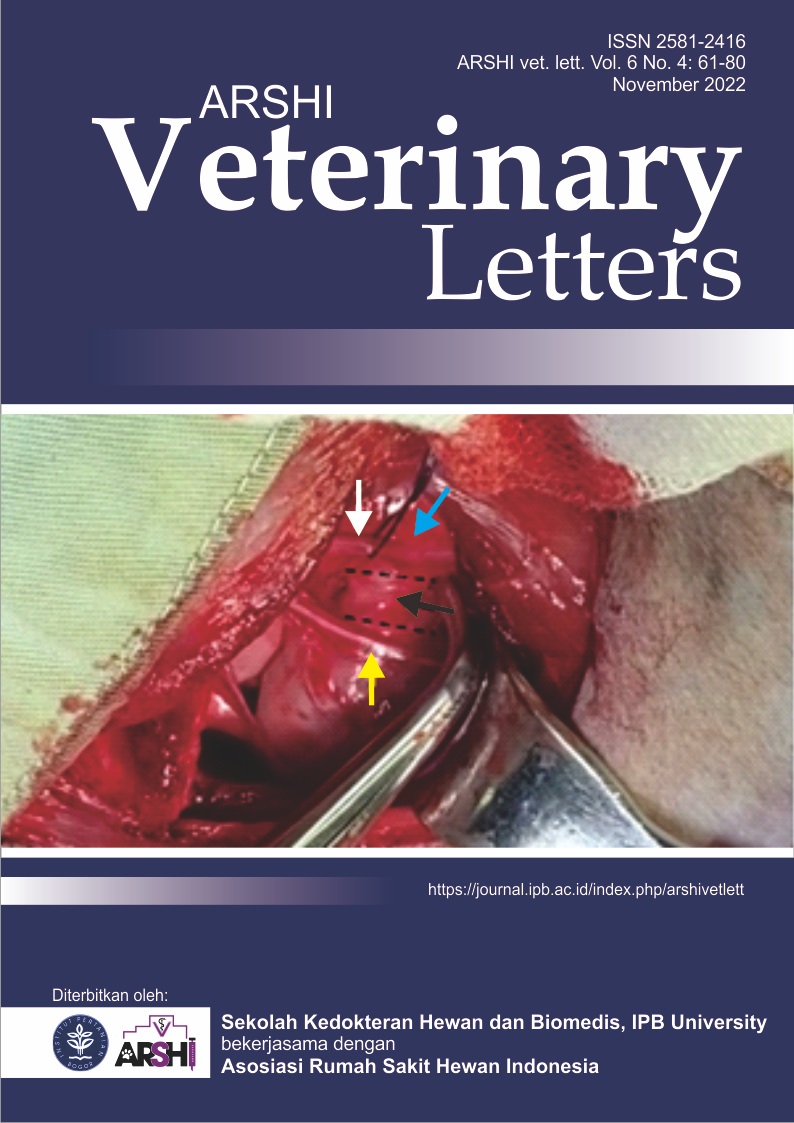Antimicrobial susceptibility of coagulase-negative staphylococci isolated from red-tailed racers (Gonyosoma oxycephalum)
Abstract
Antibiotic resistant coagulase-negative staphylococci (CoNS) have been reported around the world. The aim of this study was to determine the antimicrobial susceptibility of CoNS isolated from red–tailed racers. Samples were swabbed from the oral cavity of 5 wild caught red–tailed racers, and were identified with biochemical test using the Kirby–Bauer disc diffusion test interpreted by referring to Clinical and Laboratory Standards Institute. The results obtained 4 species of CoNS isolated from swab samples including S. sciuri, S. xylosus, S. lentus, and S. kloosii. The antibiotic resistance test of S. xylosus, S. sciuri, and S. lentus showed susceptibility to amoxicillin, gentamicin, erythromycin, bacitracin, vancomycin and oxacillin, but resistance towards penicillin G. S. sciuri isolated from snake number 1 was intermediate towards erythromycin. S. kloosii showed susceptibility towards amoxicillin, gentamicin, bacitracin, penicillin G, vancomycin, and oxacillin, but was resistant towards erythromycin
Downloads
References
Barrow GI, Feltham RKA. 2003. Cowan and Steel’s Manual for Identification of Medical Bacteria. 3rd ed. Cambridge (UK): Cambridge University Press.
CLSI. Performance Standards for Antimicrobial Susceptibility Testing. 2022. 32nd ed. CLSI supplement M100. West Valley (USA): Clinical and Laboratory Standards Institute.
Dieckmann S, Norval G, Mao JJ. 2015. A gravid Indonesian red-tailed green ratsnake (Gonyosoma oxycephalum [Boie 1827]) in the Pet Trade. IRCF Reptiles and Amphibians. 22(1):32-33.
Lowy FD. 2003. Antimicrobial resistance: the example of Staphylococcus aureus. The Journal of Clinical Investigation. 111(9):1265-1273.
Oppliger A, Moreillon P, Charrière N, Giddey M, Morisset D, Sakwinska O. 2012. Antimicrobial resistance of Staphylococcus aureus strains acquired by pig farmers from pigs. Applied and Environmental Microbiology. 78(22): 8010-8014.
Osman K, Badr J, Al-Maary KS, Moussa IM, Hessain AM, Girah ZM, Abo-Shama UH, Orabi A, Saad A. 2016. Prevalence of the antibiotic resistance genes in coagulase-positive and negative staphylococcus in chicken meat retailed to consumers. Frontiers in Microbiology. 7(1846):1-12.
Souvenir D, Souvenir D, Anderson Jr DE, Palpant S, Mroch H, Anderson J, Claridge J, Eiland J, Malone C, Garrison MW, Watson P, Campbell DM. 1998. Blood cultures positive for coagulase-negative staphylococci: Antisepsis, pseudobacteremia, and therapy of patients. Journal of Clinnical and Microbiology. 36(7):1923-1926.
Waśko A, Skrzypczak K, Polak-Berecka M, Kuzdraliński A. 2012. Genetic mechanisms of variation in erythromycin resistance in Lactobacillus rhamnosus strains. The Journal of Antibiotics. 65(11): 583-586.
Copyright (c) 2022 CC-BY-SA

This work is licensed under a Creative Commons Attribution-ShareAlike 4.0 International License.
Authors who publish with this journal agree to the following terms:
1. Authors retain copyright and grant the journal right of first publication with the work simultaneously licensed under a Creative Commons Attribution License that allows others to share the work with an acknowledgement of the work's authorship and initial publication in this journal.
2. Authors are able to enter into separate, additional contractual arrangements for the non-exclusive distribution of the journal's published version of the work (e.g., post it to an institutional repository or publish it in a book), with an acknowledgement of its initial publication in this journal.
3. Authors are permitted and encouraged to post their work online (e.g., in institutional repositories or on their website) prior to and during the submission process, as it can lead to productive exchanges, as well as earlier and greater citation of published work (See The Effect of Open Access).


.jpg)














